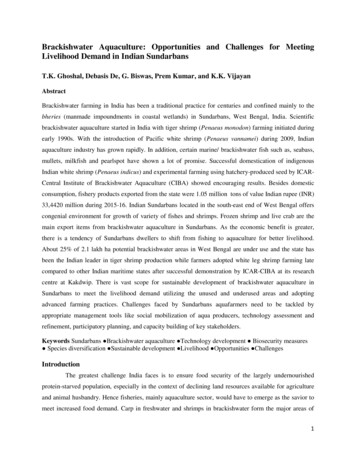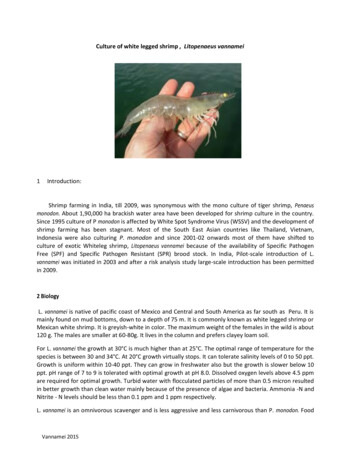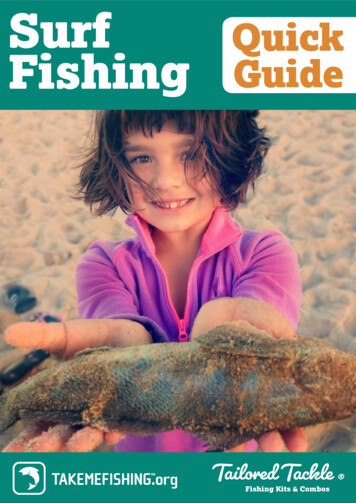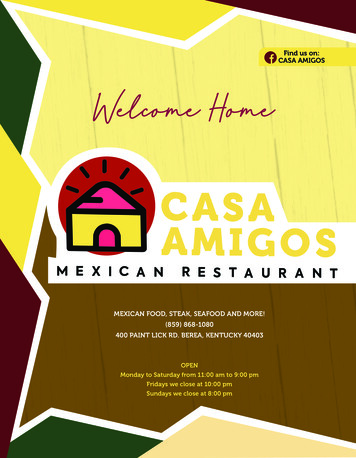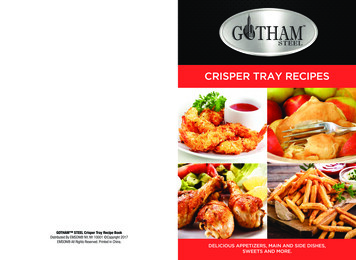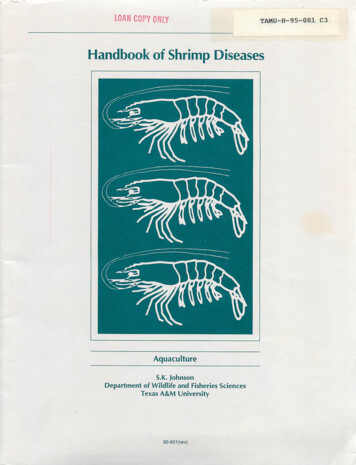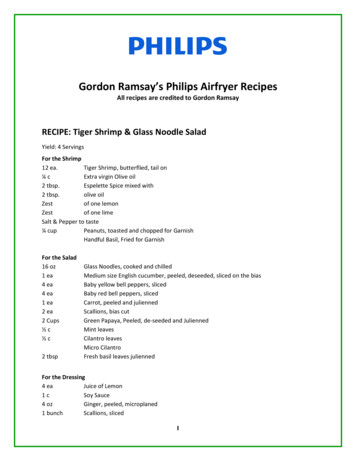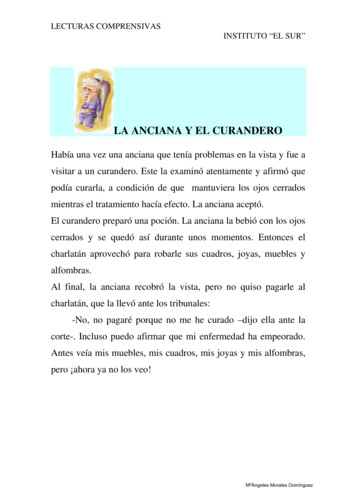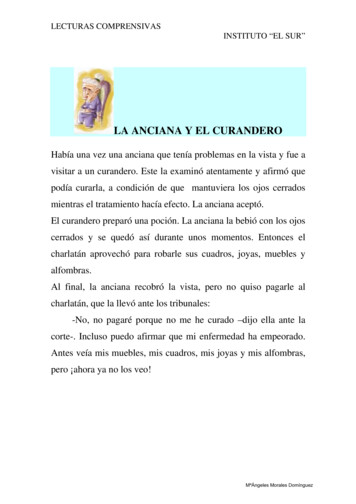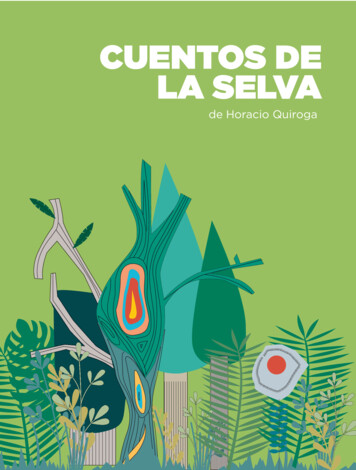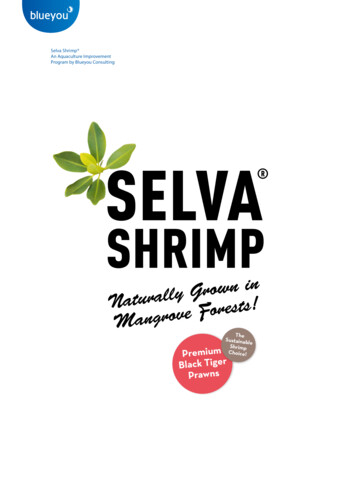
Transcription
Selva Shrimp An Aquaculture ImprovementProgram by Blueyou ConsultingSelva ShrimpTheSustainableShrimpChoice!PremiumBlack TigerPrawns
The Sustainable Shrimp ChoiceSelva Shrimp are premium-quality black tiger prawnsnaturally raised in mangrove forests. The Selva Shrimp program combines ground-level aquaculture improvement work in Southeast Asia with business-to-businessservices for sustainable shrimp sourcing and consumermarketing worldwide.Selva Shrimp black tiger prawns not only offer a sustainableseafood choice, but also create a direct link between consumers and smallholder farming communities in SoutheastAsia. Through this direct link, the program creates economic incentives to support and improve the conditions forsmall-scale shrimp farmers and more effective conservation of mangrove forests in coastal habitats.Good to know! Selva Shrimp black tiger prawnsare naturally raised with no feedand no chemicals. The mangrove forest provideshabitat and food for the shrimp. Because the shrimp dependon intact mangroves, farmersmaintain the forests.Selva Shrimp black tiger prawns are recognized by leadingenvironmental NGO’s in Europe and North America asa sustainable seafood choice due to their unique productproperties as well as the framework of aquaculture improvement and the integrity of the supply chain.NaturallyRaised23
A Unique InitiativeSelva Shrimp is a unique aquaculture improvement program: It engages with small-scale farmersthat traditionally raise shrimp by maintainingmangrove forests.The management of coastal zones in the tropics has a history of conflict between the shrimp farming industry, socio-economic development and the need for mangrove forest conservation. Against these conflicting agendas ofsocio-political priorities and policies, one method of raisingshrimp has emerged that allows for their co-existence:Integrated mangrove forest-shrimp farming.This unique approach combines the economic use of mangrove forests with shrimp aquaculture, for which the underlying principle is simple: Mangrove forests are maintainedand preserved in order to provide habitat and food for theanimals that are raised in small channels and ponds within the forest. In these systems, shrimp are raised with no feedor chemicals. The ecosystem fully relies on its own naturalproductivity, which creates incentives for farmers to maintainmangroves. The forest not only provides the shrimp withnatural food, but also provides a better and more stable income for families and communities.Incentivesefor MangrovnConservatio4Good to know!The Selva Shrimp program specificallyaddresses today’s challenges for moreeffective mangrove conservation in theface of coastal development.With the further intensification of theshrimp farming industry and increasing pressure on natural resources,Selva Shrimp not only creates a solidbasis for improvement and maintenanceof such natural shrimp farming practices, but also creates a partnership forthe sustainable development of coastal communities.5
The Selva SHRIMP EcosystemMangrove forests not only providehabitat for aquatic species, butare also the home of many speciesof birds, reptiles and other animals. Mangroves are the foundation of the foodweb, functioning as nutrient and carbon sinks and providing organic matteras a food resource for all organisms.Raised by Mother Nature!Raising shrimp in integrated mangrove forest farms is themost natural way of producing shrimp. By maintaining afunctional ecosystem of mangrove forests and aquatic species, shrimp are raised using the natural productivity ofthe surrounding forest habitat with no external inputs suchas feed, fertilizers and chemicals.Large trees may be cut selectively and sold onlocal markets to provide additional incomefor farmers. Harvested mangrove areas are reforested with juvenile mangrove trees.Great!Integrated mangrove forest shrimp farming systems are a specific type of silvofishery, which is a term used to describe aproduction system that combines forestry with fisheries oraquaculture. In addition to yielding mangrove timber, silvofishery systems also produce several species of fish, molluscand crustacean that are naturally raised together (in polyculture).Silvofishery systems offer a unique range of environmentaland social benefits since they combine integrated ecosystemservices with multiple economic benefits for local farmers.Shrimp feed on plants and small animalsprovided by the mangrove forest.Mangrove forests are maintained as functional ecosystems, offering habitat andfood to other aquatic species, such as mudcrabs, oysters and mud-jumpers.Juvenile shrimp enter the pondsby migration from the sea or areartificially stocked by the farmerusing hatchery-reared fry.67
A Framework forContinuous ImprovementSelva Shrimp is a holistic, long-term initiative for aquaculture improvement in Southeast Asia. The program develops partnerships with all stakeholders along the supplychain, creating mutual understanding, strengtheningcapacities, and offering incentives for enhancing and maintaining silvofishery shrimp farming systems.ticolis hHA roacAppAquaculture improvement does not happen overnight – rather,it is a continuous process that requires the dedicatedcommitment of all relevant actors along the production andsupply chain. The Selva Shrimp program directly linkssmall-scale farming communities with international retail andfood service companies. It facilitates the process of awareness creation, mutual understanding and capacity building forall aspects of the program – and it sets the stage for a process of continuous improvement over time.Elements of SELVA SHRIMP Aquaculture Improvement Stakeholder Awareness,Farming Practices, ShrimpQuality and Product Integrity Capacities and CapabilitiesValue Chain andMarketingOutreach, Partnerships andCo-Management Improvement of farming prac- Awareness creation and partnership building with smalltices and maintenance ofscale farming communitiesmangrove forest ecosystems Value chain promotionand economic benefits forsmallholder communities Cooperation with local authorities for coastal zone co-management and mangroveconservation Improvement of food safety,freshness and quality ofharvested shrimp Empowerment for grouporganization of small-scalefarming communities Improvement of supply chain Capacity building andknowledge transfer forintegrity and traceability ofshrimp within the supply chain better farming practices Awareness creation for biodiversity issues and mangroveprotection amongst farmingcommunities Development of Fair Trademodels Market outreach, marketingand supply chain manage-ment Cooperation with scientificinstitutions Alliances and synergies withexisting initiatives for mangrove conservation and climatechange mitigation Cooperation with carbon compensation funds for largerscale mangrove reforestationA Step-by-StepApproach toAquacultureImprovement: Certification by ASC Fair trade and value chains Scaling-up and area outreach Internal verification and audit of ICS Smallholder financing and social welfare schemes Strengthening of farmer organisation Building of farm clusters and Internal Control System (ICS) Co-management models with local forest authorities Alliances for mangrove restoration and climate change mitigation Stakeholder awareness creation and organisation building Optimization of supply chain integrity and traceability Better farming practices, food safety, shrimp quality and legal compliance Evaluation and identification of suitable shrimp-mangrove forest systems Selection of areas according to criteria of eligibility and development of traceability scheme Implementation of area-based traceability and supply chain integrityThe framework for continuous improvementincludes the following phases:1 Mangrove forest shrimp farming areas are selected accordingto eligibility criteria. A basic traceability scheme guaranteesthe integrity of the supply chain for the process of aquacultureimprovement.2 Through awareness creation and the organization of farmers,essential elements such as legal compliance, food safety,shrimp quality and supply chain integrity are managed.3 The Selva Shrimp criteria provide the basis for the aquaculture improvement of the farm clusters. The establishmentof Internal Control Systems (ICS) involves local forest management authorities and fosters the development of co-management models.Internal Control Systems (ICS)for Small-Scale AquacultureAn Internal Control System (ICS)is an instrument that has been developed for the auditing andcertification of smallholder farms.An ICS requires the smallholderfarms to build up their organizational capacities to safeguardcompliance of individual farmmembers to the standard of certification. ICS can therefore beseen as part of smallholder empowerment, strengthening anindividual farmer’s role and position in the supply chain.4 The ICS is independently verified and the organization offarmers is further strengthened. Strategic alliances are builtfor larger scale mangrove restoration.5 Independent certification by the Aquaculture StewardshipCouncil (ASC), which may be accompanied by smallholder-specificmodels of value chain promotion and Fair Trade schemes.89
Credibility and Integrity – The Heartof the Selva Shrimp ProgramIn d e p e n de n tl yVerifiedThe Selva Shrimp program aims to be effective in itsscope of improvement and strives to gain the trustand support of stakeholders along the supply chain. Inorder to achieve these goals, the program regularlymonitors progress using independent verification according to transparent and credible criteria.The Selva Shrimp program uses specific criteria and measurable parameters as guidance for all relevant processes ofaquaculture improvement. For the first phases of the program,specific criteria of improvement have been designed forsmall-scale silvofishery shrimp farms and the related supplychain. These criteria are subject to regular monitoring andindependent verification by a third-party auditing body.Selva Shrimp improvement criteria consist of two different components:Selva Shrimp – Criteria for Shrimp FarmsSelva Shrimp – Criteria for Chain of Custody (CoC) Compliance with laws and regulation Integrity of supply chain from farms to processing No wild-caught PL’s for stocking Separation of shrimp during processing until final packaging Natural stocking densities (2 – 3 PL’s / m2) Traceability back to clusters of small-scale farms No use of feed, fertilizers or chemicals Correct product labeling and packaging Ratio of forest to pond area: 50/50 Record keeping and monitoring Reforestation of mangrovesSupplyChariitnyIntegEffective Protection of endangered speciesImprovement No active predator control Documentation of all relevant processesThe Selva Shrimp criteria will be implemented through theestablishment of an Internal Control System (ICS). In alater phase of the program, the small-scale farm clusters andthe implemented ICS shall be subject to an independentassessment and certification against the standard of the Aquaculture Stewardship Council (ASC).Maintaining mangrove forests as coastal buffer zonesis a key objective of the Selva Shrimp program1011
Enhancing the Effectiveness ofMangrove Forest ConservationTraditional silvofisheries offer economic incentives tosupport reforestation efforts and the conservationof mangroves in coastal areas of Southern Vietnam.The Selva Shrimp program engages with small-scale shrimpfarms and local authorities in the coastal areas of theMekong River Delta in Ca Mau province in Southern Vietnam.The Selva Shrimp farms are situated in coastal management zones that have specifically been assigned in order tomaintain and protect mangrove forests along the Vietnamese coast.In the Mekong River Delta, the coastal zone is divided intothree different areas:Restorationof Mangroves1 Adjacent to the sea, a Buffer Zone protects the coastlineby a belt of dense mangrove forests. The buffer zone isa protected area where no mangroves can be cut.Silvofishery & Coastal ZoneManagement in VietnamCa Mau province is home to half of the remainingmangrove forests in the Mekong Delta and a third ofwhat is left in Vietnam. Over the past decades, theassignment of dedicated coastal zones for silvofisheryshrimp farming has emerged as a solution for theeconomic development of sustainable shrimp farmingwhile ensuring the maintenance of functional mangrove forest ecosystems along the coast.Silvofishery ZoneCoastal Buffer ZoneSouth China SeaThe management of mangrove forest zones in Southern Vietnam is assigned to Forest ManagementBoards (FMB’s), which coordinate and enforce existing regulations with regards to the use of mangrove forests by silvofisheries. However, due to expansion plans for intensive industrial shrimp farmingin Ca Mau province, the designated silvofishery zonesare under increasing pressure for intensification.The Selva Shrimp program is a tool that offers economic incentives and social benefits to maintainthese mangrove forest zones, supporting the local authorities and conservation efforts to safeguardmangrove forests along the coast of the MekongRiver Delta.2 The Silvofishery Zone is located inside a coastal bufferzone. In order to maintain the ecosystem of mangroveswithin these zones, the cutting of mangroves for theinstallation of ponds is limited by law.3 Further inland, there are zones for agriculture and aquaculture with no restrictions on habitat protection.4 Silvofishery shrimp farms are established along estuariesof brackish water. Individual farms typically consist ofseveral ponds or channels that are integrated into themangroves.5 The ponds and channels are connected to the estuaries by gates that can control the in- and outflow ofwater during the tidal flow.6 For the Selva Shrimp program, mangrove forest mustcover more than 50% of the total farm surface.1213
Equitable Benefits forSmallholder CommunitiesgPartnerinwithleSmall-ScaFarmersThe Selva Shrimp program creates a platform for buildingawareness and understanding of the socioeconomic importance of integrated mangrove shrimp farming systems inSoutheast Asia. Selva Shrimp creates a beneficial environment for people and ecosystems that fosters the sustainable development of this unique sector.The extensive farming of shrimp in integrated mangrove forest systems offers a range of benefits to local small-scaleproducers and the communities involved. However, there arealso constraints that may hamper the longer-term outlookof this sector, mainly driven by increased pressure on naturalresources and inadequate exposure of small-scale farmersto globalized shrimp commodity markets.An important component of the Selva Shrimp program is thecareful analysis of all aspects of socioeconomic importanceand the clear identification of the underlying factors that act askey drivers for the creation and maintenance of a beneficialenvironment for the further development of silvofishery shrimpfarming in Vietnam and other countries in Southeast Asia.1ortingSelf-SuppdsLivelihooSelva Shrimp creates equitable benefits for small-scalefarmers and communities through a multilevel approach,which encompasses the following elements:2Financing&SchemesSocialWelfare4nValue Chaie& Fair Trad1 The fostering of self-supporting livelihoods through betterfarming practices, increased yields and less risk of crop failure2 The creation of financing and social welfare schemesfor farmers and communities3 The strengthening of farmers’ capacities and capabilitiesby organisation building and training4 Value chain promotion and models of fair trade3ion &OrganisatBuildingyitacCap1415
Natural taste, vibrant colour, succulence and firmtexture – nurtured by mangrove forests, Selva Shrimp is an exquisite sustainable seafood choice!ExquisiteShrimp!Selva Shrimp : Delicious Black TigerPrawns for Pure EnjoymentNaturally grown in mangrove forests, Selva Shrimp offera unique experience of exquisite taste and texture.The Selva Shrimp program offers a sustainable seafood choiceand, by using an integrated quality assurance system, guaranteesthe highest product quality, freshness and food safety. Blacktiger prawns are harvested during high and low tides, when adultshrimp are naturally drawn towards the sea. Selva Shrimp arecaught by net and immediately put on ice to preserve freshnessand their natural taste. In the early morning, harvested shrimpare gathered through collecting stations and brought to the processing plant where shrimp are manufactured into frozen finalproducts according to customers’ specifications.The Selva Shrimp ManufacturingPartner in VietnamStringentQualitySelva Shrimp black tiger prawns areexclusively processed and manufactured by Minh Phu Seafood Corporation. As the leading shrimp processing company in Vietnam, Minh Phunot only guarantees the highestproduct quality and food safety of SelvaShrimp , but also offers clients awide range of manufactured frozenshrimp products.Standards1617
Creating Value forBusinesses and ConsumersTheSelva ShrimBrandp Selva Shrimp offers client-based solutions for communication, product placement and marketing, recognizingboth the value of the Selva Shrimp aquaculture improvement program as well as the unique quality and properties of premium frozen black tiger prawn products.A Guarantee for Product Integrity:Selva Shrimp as a Business-to-Business Sourcing SolutionMarket participants interested in becoming part of theSelva Shrimp aquaculture improvement initiative can directlysource final products and use Selva Shrimp for existingprivate retail or wholesale seafood brands. Dedicated marketpartners benefit from a full range of business-to-businessservices: Product and supply chain integrity and traceability Quality assurance, freshness and food safety Monitoring and verification of aquaculture improvement Integrated supply chain management for reliable suppliesCreating Value for Consumers:Selva Shrimp as a Consumer BrandThe unique properties of Selva Shrimp are best promotedand recognized by the Selva Shrimp consumer brand.Existing packaging, communication and promotion solutionsare available for committed market actors that choose tolaunch and offer Selva Shrimp products to their clients in theform of a consumer-facing brand.The Selva Shrimp packaging design recognizes the uniqueproperties of premium black tiger prawns from integratedmangrove forest systems. Packaging solutions are available forall forms of frozen products and can be adapted accordingto our clients’ isit us at:www.selvashrimp.comFor market partners that promote and distribute Selva Shrimp as a consumer brand, the program offers a set of communication and marketing materials that can be tailored to thespecific needs of their market segment and the realities ofclients on the consumer level.1819
Selva Shrimp is an aquaculture improvementinitiative developed and managed byBlueyou Consulting Ltd in Southeast Asia.Blueyou Consulting is an internationallyrecognized consulting and service company thatfocuses on sustainable fisheries and aquaculture and their related seafood supply chains.The Blueyou team of consultants includesbusiness professionals in the field of fisheries andaquaculture as well as those in supply chainmanagement, logistics and marketing.Blueyou Consulting works within an extensivenetwork, which includes governmental andnongovernmental organisations, scientific researchinstitutions as well as private companies inthe seafood production and market sectors. 2012 Blueyou Consulting Ltd. All rights reserved.Selva Shrimp is a registered trademark ofBlueyou Consulting Ltd.All other trademarks are the property of theirrespective owners.www.blueyou.comPrinted on FSC certified paper, CO2 neutralwww.fsc.org, Cert. no. SGS-COC-002021
4 5 a Unique initiative Selva Shrimp is a unique aquaculture improve- ment program: It engages with small-scale farmers that traditionally raise shrimp by maintaining

